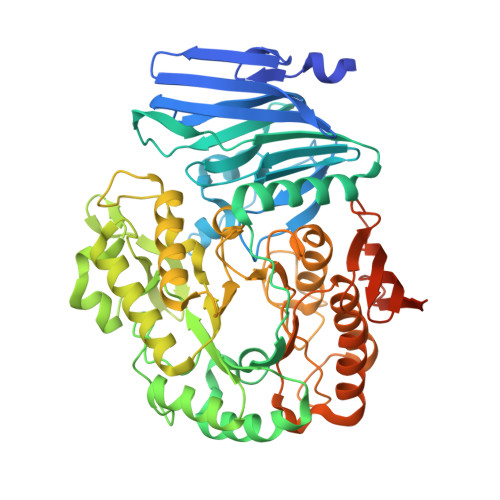Revealing the mechanism for covalent inhibition of glycoside hydrolases by carbasugars at an atomic level.
Ren, W., Pengelly, R., Farren-Dai, M., Shamsi Kazem Abadi, S., Oehler, V., Akintola, O., Draper, J., Meanwell, M., Chakladar, S., Swiderek, K., Moliner, V., Britton, R., Gloster, T.M., Bennet, A.J.(2018) Nat Commun 9: 3243-3243
- PubMed: 30104598
- DOI: https://doi.org/10.1038/s41467-018-05702-7
- Primary Citation of Related Structures:
6GTA, 6GVD, 6GWF, 6GWG, 6GX8 - PubMed Abstract:
Mechanism-based glycoside hydrolase inhibitors are carbohydrate analogs that mimic the natural substrate's structure. Their covalent bond formation with the glycoside hydrolase makes these compounds excellent tools for chemical biology and potential drug candidates. Here we report the synthesis of cyclohexene-based α-galactopyranoside mimics and the kinetic and structural characterization of their inhibitory activity toward an α-galactosidase from Thermotoga maritima (TmGalA). By solving the structures of several enzyme-bound species during mechanism-based covalent inhibition of TmGalA, we show that the Michaelis complexes for intact inhibitor and product have half-chair ( 2 H 3 ) conformations for the cyclohexene fragment, while the covalently linked intermediate adopts a flattened half-chair ( 2 H 3 ) conformation. Hybrid QM/MM calculations confirm the structural and electronic properties of the enzyme-bound species and provide insight into key interactions in the enzyme-active site. These insights should stimulate the design of mechanism-based glycoside hydrolase inhibitors with tailored chemical properties.
Organizational Affiliation:
Department of Chemistry, Simon Fraser University, 8888 University Drive, Burnaby, BC, V5A 1S6, Canada.



















